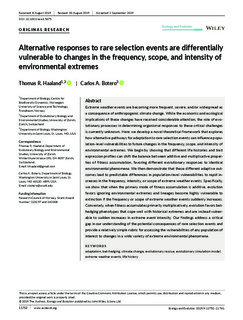| dc.contributor.author | Haaland, Thomas | |
| dc.contributor.author | Botero, Carlos A. | |
| dc.date.accessioned | 2020-02-20T09:43:58Z | |
| dc.date.available | 2020-02-20T09:43:58Z | |
| dc.date.created | 2020-01-09T12:43:12Z | |
| dc.date.issued | 2019 | |
| dc.identifier.citation | Ecology and Evolution. 2019, 9 (20), 11752-11761. | nb_NO |
| dc.identifier.issn | 2045-7758 | |
| dc.identifier.uri | http://hdl.handle.net/11250/2642799 | |
| dc.description.abstract | Extreme weather events are becoming more frequent, severe, and/or widespread as a consequence of anthropogenic climate change. While the economic and ecological implications of these changes have received considerable attention, the role of evolutionary processes in determining organismal responses to these critical challenges is currently unknown. Here we develop a novel theoretical framework that explores how alternative pathways for adaptation to rare selection events can influence population‐level vulnerabilities to future changes in the frequency, scope, and intensity of environmental extremes. We begin by showing that different life histories and trait expression profiles can shift the balance between additive and multiplicative properties of fitness accumulation, favoring different evolutionary responses to identical environmental phenomena. We then demonstrate that these different adaptive outcomes lead to predictable differences in population‐level vulnerabilities to rapid increases in the frequency, intensity, or scope of extreme weather events. Specifically, we show that when the primary mode of fitness accumulation is additive, evolution favors ignoring environmental extremes and lineages become highly vulnerable to extinction if the frequency or scope of extreme weather events suddenly increases. Conversely, when fitness accumulates primarily multiplicatively, evolution favors bet‐hedging phenotypes that cope well with historical extremes and are instead vulnerable to sudden increases in extreme event intensity. Our findings address a critical gap in our understanding of the potential consequences of rare selection events and provide a relatively simple rubric for assessing the vulnerabilities of any population of interest to changes in a wide variety of extreme environmental phenomena. | nb_NO |
| dc.language.iso | eng | nb_NO |
| dc.publisher | John Wiley & Sons Ltd. | nb_NO |
| dc.rights | Navngivelse 4.0 Internasjonal | * |
| dc.rights.uri | http://creativecommons.org/licenses/by/4.0/deed.no | * |
| dc.title | Alternative responses to rare selection events are differentially vulnerable to changes in the frequency, scope, and intensity of environmental extremes | nb_NO |
| dc.type | Journal article | nb_NO |
| dc.type | Peer reviewed | nb_NO |
| dc.description.version | publishedVersion | nb_NO |
| dc.source.pagenumber | 11752-11761 | nb_NO |
| dc.source.volume | 9 | nb_NO |
| dc.source.journal | Ecology and Evolution | nb_NO |
| dc.source.issue | 20 | nb_NO |
| dc.identifier.doi | 10.1002/ece3.5675 | |
| dc.identifier.cristin | 1769320 | |
| dc.description.localcode | © 2019 The Authors. This is an open access article under the terms of the Creative Commons Attribution License, which permits use, distribution and reproduction in any medium, provided the original work is properly cited. | nb_NO |
| cristin.unitcode | 194,66,10,0 | |
| cristin.unitname | Institutt for biologi | |
| cristin.ispublished | true | |
| cristin.fulltext | original | |
| cristin.qualitycode | 1 | |

